

| 
|
There are many legends about St. Patrick, but this is his story.
Much of Patrick’s life is shrouded in mystery. Historians disagree on many dates and places in his life story. Patrick was born sometime around 380 in Scotland or Wales.
As a boy of about fifteen or sixteen, he was captured during a raiding party. He was taken to Ireland as a slave to herd and tend sheep for an Irish chieftain named Milchu who lived on Slemish Mountain in County Antrim. Patrick's captivity lasted six years. He escaped after he had a dream from God in which he was told to leave Ireland by going to the coast. After a journey of 200 miles, he found a ship which took him back to Britain, where he was reunited with his family.
After his return to Britain, he had another dream in which the people of Ireland were calling out to him "We beg you, holy youth, to come and walk among us once more." He recorded his call to his vocation (and other dreams from God) in the "Confessio," his spiritual autobiography. It is one of his few writings that have survived. He left the comfort of his family for France where he began his studies for the priesthood in continental monasteries. Many believed he was ordained by St. Germanus, the Bishop of Auxerre, France, whom he had studied under for years. Later, Patrick was ordained a bishop. His only other writing to survive, "Epistola" pleads the case for the Christian Irish at the hands of their British conquerors. Both writings show him as a humble, gentle man of faith.
It is believed that Patrick was sent to Ireland as a bishop to replace Saint Palladius who died in 431. He arrived in Ireland in 432 or 433, at Slane. One legend says that he met Dichu, a chieftain of one of the tribes, who tried to kill Patrick. Patrick converted Dichu after he was unable to move his arm until he became friendly to Patrick. Dichu gave Patrick a barn at Saul, county Down for his first church.
Despite constant threats to his life, Patrick traveled widely through Ireland, baptizing, confirming, and preaching. He converted thousands and began building churches, monasteries, and schools all over the country. Through the power of Patrick's message, Kings, their families, and entire kingdoms converted to Christianity. It is said that he and his disciples converted almost all the population of Ireland. He eventually made his headquarters in Armagh.
One legend had him spend 40 days on a mountain in county Mayo, now known as Croagh Patrick. He was harassed by demons in the form of blackbirds, clustered so densely that the sky was black, but he continued to pray, and rang his bell to disperse the assailants. An angel then appeared to tell the saint that all his petitions for the Irish people would be granted, and that they would retain their Christian faith until Judgment Day.
Patrick is credited with banishing all the snakes from Ireland. This is probably a metaphor for his driving the pagans from Ireland as snakes were often associated with pagan worship. Another well known legend had Patrick using the shamrock (which resembles a three leaf clover) to explain the Trinity as the Father, Son, and Holy Ghost. It has been associated with him and the Irish since that time.
After years of living in poverty, traveling and enduring much suffering he died March 17, 461. He died at Saul, where he had built the first church and is reputedly buried at nearby Downpatrick.
Today, Irishmen wear shamrocks, the national flower of Ireland, in their lapels on St. Patrick's Day, March 17.
 His parents were Calpurnius and Conchessa, who were Romans living in Britain in charge of the colonies. His real name was believed to be Maewyn Succat as he took the name Patrick (or Patricus) after he became a priest.
His parents were Calpurnius and Conchessa, who were Romans living in Britain in charge of the colonies. His real name was believed to be Maewyn Succat as he took the name Patrick (or Patricus) after he became a priest.
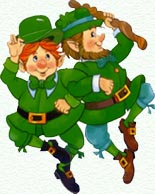
| 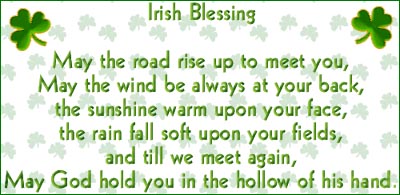
|  |

The national flag of Ireland is the tricolor of green, white and orange.
The flag is divided into three equal stripes and its width is equal to twice its height. It is used as the civil and naval design.
The green stripe represents those of native Irish decent. The orange stripe represents the 17th century British colonists (a group which supported William of Orange in the War of the Two Kings), and the white stripe represents the hope for peace between the two groups.
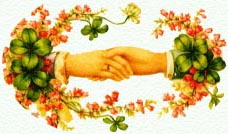
Here is a question for you: Why do so many Irish names begin with "O'"?
With St. Patrick's Day approaching, there will soon be lots of "O's" in the air. I wonder how many people who will be affecting an Irish accent will know just what this name form is all about.
It reflects a practice found in many cultures: The use of the "patronymic." Last names originated in the Middle Ages when men, who embodied the continuity of the family, started to be identified by their relationship to their immediate ancestors.
The son of David, for example, might take the name Davidson. The Scots used "Mac," which meant "the son of," for this purpose. And so with the Irish and the "O'," except here it meant "the grandson of," possibly because one of the first to use it, Teigue, grandson of Brian, High-King of the Irish in the 11th century, started to call himself Ua Briain (Gaelic for O'Brian) after his famous grandfather. (Source: ENCYCLOPEDIA BRITANNICA)
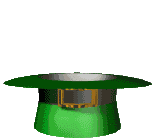

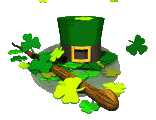
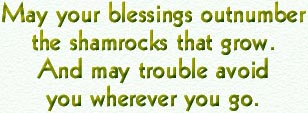


 | |
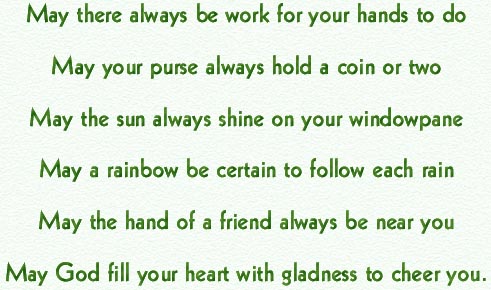
| 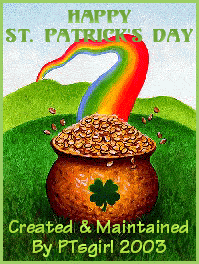 |